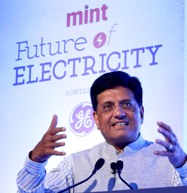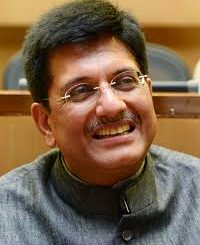
While the power generating capacity of NLCIL till 2014 is 2740 MW, by the meticulous planning of the Company as well as the Union Coal Ministry, now it is operating power stations with a capacity of 4295 MW. Achieving the Mission of 24×7 Affordable Clean ‘Power for All’ and ensuring the optimum utilization of natural resources for national development are critical to ‘Ujwal Bharat’ which will help in realizing Prime Minister of India, Shri Narendra Modi’s vision of New India .
Over the past three years, the Ministries of Power, Coal, New & Renewable Energy and Mines have made considerable progress towards achieving this goal. NLCIL joined hands with the Union Government to realise the Mission of “Power for All”and synchronised two Thermal Power Station namely Thermal Power Station-II Expansion (2 X 250 MW), NTPL Thermal Power Station (2 X 500 MW) run by NLC Tamil Nadu Power Ltd., a Joint Venture with Tamil Nadu Generation & Distribution Corporation Ltd., during the last 3 years period. In addition, the company entered into the green energy sector and installed Wind Turbines of 51 MW Capacity at Tirunelveli district of Tamil Nadu . (46.50 MW commissioned and the 4.50 MW will be commissioned soon).
The Company also established Solar Power Project of 10 MW at Neyveli itself. Apart from this, Thermal Power Projects construction is going on in different parts of the country. (Neyveli 2 X 500 MW, Uttar Pradesh 3 X 660 MW, Rajasthan 2 X 500 MW, Retiring of TPS-I (-) 600 MW). By the end of 2021 the Company’s power Generating capacity will be raised to 7811 MW. The Company also plans to achieve 20971 MW within 2025. In addition, NLC India Ltd., is having an ambitious plan to setting 4000 MW Solar Power Projects in association with State Governments in line with Solar Mission. Presently work for 130 MW Solar Power Project at Neyveli and 500 MW Solar Power Project at different parts of Tamil Nadu is going on. 2 Three Years’ Achievements & Initiatives of the Ministries of Power, Coal, New & Renewable Energy and Mines Coal: Shortage to surplus, surplus to superior To ensure adequate coal for electricity, Government has set a goal to produce 100 crore tonnes of domestic coal by 2019-20.
The 9.2 crore tonne increase in production of coal in the three years since 2014. This increase took about seven years before 2014. While nearly two-thirds of the power plants were reeling critical coal stocks in 2014, there is no shortage of coal now. Through reduced coal imports to make the nation self-reliant, foreign exchange worth Rs. 25,900 crores has been saved. The principle of “less coal for more power” has yielded results. In 2016-17, 0.63 kgs of coal was used to produce 1 kWh of electricity (specific coal consumption), versus 0.69 kgs in 2013-2014, a reduction of 8%.
This ensures cheaper as well as cleaner electricity. Further, coal linkage rationalization of 4 crore tonnes of coal will result in potential savings of about Rs. 3,000 crores. Power Government’s unprecedented efforts to brighten up the nation and the lives of its people are succinctly captured by NASA’s before-and-after satellite photosTo explain the transition, the National Geographic magazine writes – “India has brightened dramatically, is not a surprise. The country is home to more than its fair share of people living without electricity, and its Government has been working to change that by establishing a rural electrification program and investing heavily in renewable energy.” All States have signed the ‘Power for All’ agreements highlighting Government’s commitment to the principle of Cooperative Federalism. SHAKTI (Scheme for Harnessing and Allocating Koyala Transparently in India) is a transformational policy for auction and allotment of coal linkages and will lead to affordable power, access to coal and accountability in the allocation of coal. The Mega Power Policy will facilitate competitive bidding for future Power Purchase Agreements and ensure long term project viability.
The highest ever 60GW addition in conventional power, about 40% increase in transformation capacity, and over one-fourth increase in transmission lines since April 2014- March 2017, have made India a power surplus country, with no shortage of electricity or coal. ‘One Nation, One Grid, One Price’ was further strengthened with surplus electricity available at affordable rates for States. For the first time, India became a net exporter of electricity in 2016-17. UDAY (Ujwal DISCOM Assurance Yojana), as a comprehensive reform of the distribution sector saw progress, with savings of nearly Rs. 12,000 crores for DISCOMs due to issuance of UDAY Bonds worth Rs. 2.32 lakh crore. These savings will help in providing 4 affordable power to consumers. Through reforms, India’s ranking in ‘Ease of Getting Electricity’ by the World Bank rose from 99 in 2015 to 26 in 2017. Government is driven by ‘Antyodaya’ – serving the last man at the bottom of the pyramid, based on the philosophy of Pandit Deen Dayal Upadhyaya. The birth centenary year of this great philosopher, humanist and nationalist is being commemorated as Garib Kalyan Varsh. The flagship scheme for rural electrification (DDUGJY – Deen Dayal Upadhyaya Gram Jyoti Yojana) has received special attention. Less than 4,000 of the 18,452 remaining un-electrified villages (as of 1st April 2015) remain, and will be electrified by May 2018. To ensure light in not just every village but every home, the Government has set the target of electrifying every household by 2022. About 4.5 crore rural households remain, as per data submitted by the States. India has received world recognition for its energy efficiency initiatives. More than 23 crore LED bulbs have been distributed under UJALA (Unnat Jyoti by Affordable Electricity for All), and this has served a twofold purpose – helped save Rs. 12,400 crores in electricity bills, and reduced CO2 emissions by over 2.5 crore tonnes annually.
New & Renewable Energy As declared emphatically by the Prime Minister of India remains fully committed to protecting the environment, which is an Article of Faith for us. In 2016-17, India crossed major milestones in the mission of achieving 175 GW of renewable power by 2022. By introducing competitive bidding, Government has ensured that renewable energy is affordable and attractive for consumers. 2016-17 saw the lowest tariffs in both solar (Rs. 2.44) and wind (Rs. 3.46) energy. In a groundbreaking development, 2016-17 also marks the first year when net capacity addition of renewable energy was higher than that conventional energy. The past year also saw the highest ever addition of solar and wind power. Mining Through a combination of sound policy and technology, the Government has embarked on a plan to bring transparency to the mining sector and optimize utilization of natural resources. The National Mineral Exploration Policy 2016 aims to accelerate exploration through National Aero-Geophysical Mapping Project, which will acquire data on 27 lakh line kms of aero-geophysical data by 2019, versus 7 lakh line kms in the last 30 years. Amending the legislative framework for allotment of offshore blocks will kick start offshore mining activity. Transparent auction of 24 mineral blocks will lead to estimated revenue of over Rs. 1 lakh crore to the States over the lease period of the mines. Using space technology, the Mining Surveillance System (MSS) acts as an eye in the sky to check illegal mining. 5 To ensure that people affected by mining benefit from this activity, Government has started Pradhan Mantri Khanij Kshetra Kalyan Yojana (PMKKKY), which has already covered 11 out of 12 mineral-rich states. The District Mineral Foundation (DMF) under PMKKKY has collected about Rs. 7,150 crores from mining in 2016-17, which will be used for education, healthcare and welfare measures specifically for mining affected people and areas.
Accountability and Transparency through Mobile Apps Government is also operating under the highest standards of transparency and accountability with ‘consumer is king’, at the heart of all efforts. The launch of various apps to track the functioning of various departments and schemes is part of this. Some of the apps launched in the past year include URJA to track electricity situation in urban areas and the progress of the Integrated Power Development Scheme (IPDS), TARANG to track transmission projects and URJA MITRA for power cut information. All the apps of the four Ministries can be downloaded by giving a missed call number to 18002003004. The first two years set us on the path to achieving the highly ambitious goals that Government has set. The journey during the third has brought the targets within sight, and laid the foundation of Ujwal Bharat. Over the next two years, the dream of achieving 24×7 affordable clean “Power for All” will move towards completion, and lead us towards New India. Finally, the promise of electricity is displacing the despair of darkness even in the remotest corners of the country, the hitherto unaffordable renewable energy is becoming accessible, and natural resources are being utilized for the sustainable development of people – all of these are yielding the crucibles of New India.







Leave a Reply
You must be logged in to post a comment.